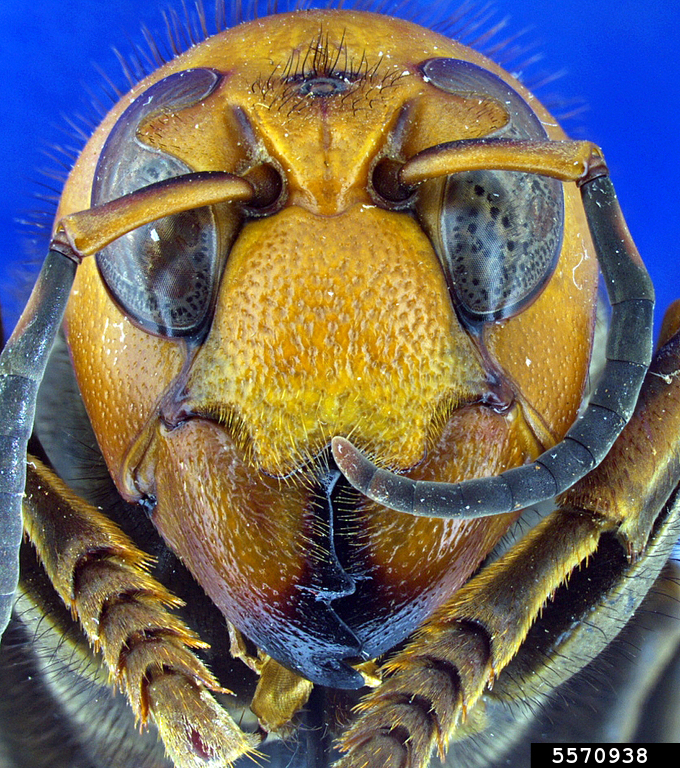Before we get too deep, yes, a 5cm long wasp can be terrifying.
But the good news? They aren’t especially aggressive and don’t randomly attack people or pets.
The Asian giant hornet (Vespa mandarinia spp.) is the world’s largest species of hornet and comes with many nicknames you may see flooding the internet right now – i.e., murder hornets.
Native to the subtropical and temperate regions of Asia, the first sightings of this hornet in North America occurred in the fall of 2019 in Washington state and British Columbia and there has been an array of reports in the Pacific Northwest since. Luckily, there have been no other credible reports (that we can find) in the eastern United States or Canada.
Asian giant hornets can reach a whopping 2 inches long with a 6mm stinger, with an especially toxic venom. They are social insects that are most commonly found in forested habitats and typically nest in the ground. They primarily feed on other insects and are known to create group attacks against other social species, like the honeybee. Which is primarily why they got their nickname as the murder hornet. A few of these hornets can destroy a honeybee hive in a matter of hours. The hornets enter a “slaughter phase” where they kill bees by decapitating them. They then defend the hive as their own, taking the honeybee brood to feed their own young. They also attack other insects but are not known to destroy entire populations of those insects like they do the honeybee. Asian honeybees are known to have specific reactions and signals in response to the hornets, which doesn’t seem to be happening in places like Europe or in studies in Pacific Northwest.
To answer the question you may now be asking – What can I do to help?
Your action is important in slowing the spread of ALL invasive species. Areas including Washington, British Columbia and many countries in Europe are calling upon citizen scientists to report sightings of the Asian giant hornet. Though this hornet is not yet known to be in the St. Lawrence Eastern Lake Ontario region, but you can help enhance our early detection efforts of other invasive species threatening our region by joining our invasive species Volunteer Surveillance Network. First and foremost, plant natives species to protect our native pollinators… did you know that honeybees aren’t actually native to our region? Native plants are known to attract native pollinators which include bees, beetles, butterflies, and even flies!
Check out our newsletter article about the Power of Natives.
Join our Pollinator Pathway Project (Project Concept and Brochure)
Know before you grow, PlantWise NY!
And of course, volunteer with us!
Additional Information and Resources:
Below are some photos showing the defining characteristics of the invasive Asian giant hornet. To learn of distinguishing features between the giant hornet and some look-a-likes visit the Washington State Department of Agriculture website.

Closeup image of Vespa mandarinia ssp. japonica adult worker Photo by Allan Smith-Pardo, USDA APHIS, Bugwood.org

Closeup image of Vespa mandarinia ssp. magnifica adult worker and large 6 mm long stinger, which can deliver a large dose of venom. Photo by Allan Smith-Pardo, USDA APHIS, Bugwood.org

Closeup image of Vespa mandarinia adult female. Photo by Allan Smith-Pardo, USDA APHIS, Bugwood.org
USDA New Pest Response Guidelines Vespa mandarinia
Cutaneous_hemorrhage_or_necrosis_findings_after_Vespa mandarinia stings
Interspecific_variation_in_competitor_avoidance_and foraging success in sap-attracted insects
Below are a couple of interesting studies and a video about the honey bee, which is not actually native to our region, and their response to the hornet in Asia:
Featured Image: Closeup image of Vespa mandarinia ssp. japonica Queen. Note the large mandibles which are used to grasp, crush, or cut food, or to defend against predators or rivals. Photo by Allan Smith-Pardo, USDA APHIS, Bugwood.org


